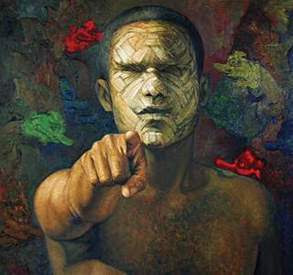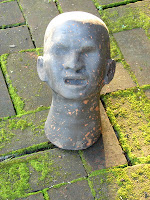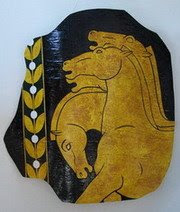
The
“Camouflage: Acts of War” by
Hamad Khalaf will go at Friday, August 31-2007, on 7 p.m. This exhibition is curated by
Rifky Effendy and will be officiated by Mr
Deddy Irianto, the owner of
Langgeng Icon Gallery. The exhibition will last at September 9-2007. Art lovers are welcome with no admission.
Khalaf is a Kuwait born artist and now he is working in Bali. "ACTS OF WAR" is a project which started in 2003, when Hamad Khalaf set up his studio in Bali, Indonesia. In view of the many restrictions his work would face in Kuwait, he chose to further his career in Indonesia as an alternative home base for an international career. The project comprises art work in a broad range of mediums, all revolving around one central idea: Classical Greek Mythology abounds in characters and situations of War, which our reality would seem to imitate.
Excerpts from some sources:
"Bagi banyak seniman, mitos Yunani kemudian dijadikan titik keberangkatan untuk membincangkan tragedi manusia. Melalui benda dan citraan yang penuh erotika lagi puitik, Hamad Khalaf, seorang perupa, mengajak kita merenungi tentang perang lewat mitologi." KOMPAS, Rifky Effendy
"He could not resist collecting, from deserted military battlefields, the military helmets, uniforms, gloves, gas masks, flasks, and other remainders of the war that raged in Kuwait. Khalaf blows new life into these Iraqi military items with artistic gusto." ASIAN ART NEWS, Carla Bianpoen
"The combination of objects from war and epic greek imagery reveals the red thread of human drama. Whether the objects are truly from war or not is of no importance, because we consume war images no differently to other images. We are enticed by the imagery and enjoy reproducing it. While real war takes civilian casualties, its imagery camouflages it to some of the others." MEDIA INDONESIA, Heru Hikayat
"The more I saw, the closer I looked at the objects and the scenes painted on them, and the more was realed about the fascinating way the whole world of objects came together in harmony, and evoking, destruction, war and mythology. I was looking at a highly sophisticated and personal message against war and violence." JAKARTA POST, Jean Couteau
"In its essence, trauma can never be healed. It can only be managed, transformed into positive energy. This is what Hamad does." GALERI SOEMARDJA, Aminuddin TH Siregar
HAMAD KHALAF Born 1971
Solo Exhibitions
2007
“Camouflage: Acts of War”, Rumah Seni Yaitu, Semarang, Cent Java, Indonesia
“Acts of War”, 24hr Art (N.T. Centre for Contemporary Art), Darwin, Australia.
“Acts of War”, Galeri Cemara 6, Jakarta, Indonesia.
“Acts of War”, Galeri Soemardja -ITB, Bandung, Indonesia.
“Acts of War”, Gaya Fusion Artspace , Bali, Indonesia.
2006
“Acts of War”, Curated by Enin Supriyanto, Nadi Gallery, Jakarta, Indonesia.
2005
“Acts of War”, Curated by Filippo Sciascia, Gayafusion, Bali, Indonesia.
2001
“The Fires of Kuwait”, The Green Room, Ritz Carlton Hotel, Singapore.
1999
“Enemy Revisited”, Salle des Pas Perdus, UNESCO Headquarters, Paris, France.
1998
“Les Argonauts”, Hall Moro III, UNESCO Headquarters, Paris, France.
1997
“Enemy Revisited”, Musee de Louvain La Neuve, LLN, Belgium.
“Enemy Revisited”, Galerie Catrin Alting, Antwerp, Belgium.
1996
“Mitologia Crudele”, Loggia Rucellai – Galerie Alberto Bruschi, Florence, Italy.
1995
“Enemy Revisited”, Le Centre Culturel Francais, Kuwait.
Group Exhibitions
2006
“Theertha Open Day”, Organized by Theertha IAC. Hantane, Sri Lanka.
“Gaya Collection”, Gayafusion. Bali, Indonesia.
2005
“3 Regards sur la guerre”, Abbaye de Stavelot, Stavelot, Belgium.
“Pre-Bali Biennale”, Sika Gallery, Bali, Indonesia.
“Bali Biennale-Summit Event”, Komaneka Gallery, Bali, Indonesia.
2004
“Artiade - Olympics of Visual Arts”, Athens, Greece.
1996
“Artiade - Olympics of Visual Arts”, Atlanta, Georgia, USA.
Projects Assignments / Workshops
2006
Theertha International Artists Workshop, Hantane, Sri Lanka.
2005
Created 40 art masks for sale at charity masquerade “Friends of Indonesia”, Fabio’s, Bali, Indonesia.
2004
Member of the International Jury, Artiade Olympics of Visual Arts, Athens, Greece.
1998
Desk Calendar, Mobile Telecommunications Company (MTC), Kuwait.
1997
Cards and “Minotaur” Watch sold at UNESCO HQ, Paris, France.
Collections
Nadi Gallery, Jakarta, Indonesia.
Gayafusion, Bali, Indonesia.
Musee de Louvain La Neuve, LLN, Belgium.
Maison de L’UNESCO, Paris, France.
Associasion Internationale des Arts Plastiques (AIAP), Paris, France.
Artiade Foundation (NGO), Berlin, Germany.
Professor Nicholas Saunders, Author of Trench Art books.
Miuccia Prada, Fashion designer and co-founder of the Prada Foundation, Milan, italy.
Studies & Day Jobs
2001-2003
Senior Representative, Kuwait Petroleum Far East, Singapore.
1994-2001
Oil Trader/Retail Analyst, Kuwait Petroleum Corporation, Kuwait/Rotterdam.
1992-1994
Assistant Admin. Director, SOFREMI (Demining & Ordinance Disposal company operating in Kuwait)
1989-1992
BBA in Marketing and International Business, Schiller International University, Paris, France.




























 Rumah Seni Yaitu:
Rumah Seni Yaitu:

 Photography: Tubagus P. Svarajati
Photography: Tubagus P. Svarajati






+of+DSC05301.jpg)




